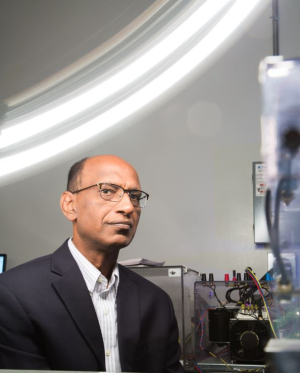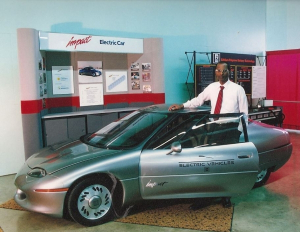There are many ways to describe electrical and computer engineering Professor Kaushik Rajashekara, who heads the Cullen College power and energy systems program and is director of the Power Electronics, Microgrids and Subsea Electrical Systems (PEMSES) Center at UH: Member of the National Academy of Engineering, Fellow of the National Academy of Inventors, inductee of the Delphi Innovation Hall of Fame or, even, a member of the team that developed the General Motors EV1, the first mass-produced electric car from a major automaker.
But the title Rajashekara likes most is “futurist.”
“When people ask me what I work on, I always say ‘the future,’” said Rajashekara, former chief scientist at General Motors/Delphi and chief technologist at Rolls-Royce.
It’s a spot-on answer for the scientist who has consistently worked on futuristic projects and brought them to life. After ushering in the era of electric and hybrids cars from 1989-2006 by advancing the technologies including the EV1, he left his position at GM/Delphi for his next revolutionary project. At Rolls Royce, he worked on advanced architectures for more electric and hybrid electric aircrafts bringing to life his notions of converting ancillary equipment used on aircrafts (like air conditioning and cooking devices) to electricity, leading to next generation aircrafts beyond the 787 Dreamliner-type.
Now, with those futuristic projects in the past, he says the next big thing will be flying cars – and he’s all in. If his track record is proof, it may be time to look skyward for a parking spot.
“Just last week I gave a lecture in India about flying cars. I give talks about them all over the world,” said Rajashekara. He is propelled in his pursuit by his desire to preserve the environment. “If you have a flying car, you don’t have to build as many bridges or cut as many trees,” he offers, with a logic that makes his science fiction-sounding future appear to be just plain practical.
Down to earth at UH
His pursuits at the Cullen College are a bit more terrestrial.
“I’m a power and energy guy,” said Rajashekara, who points out that most energy courses and majors at UH and other universities are related to petroleum or chemical engineering.
But to him, power means the energy of electricity, the magic that happens after converting the various petrochemicals and turning on the light switch.
“It is very important that electric energy gets importance at the University of Houston,” he said. And so, in the past year since he’s been at the Cullen College, Rajashekara has gone about creating the certificate program to prepare students to design electrical systems for the power and energy industry. The program offers two certificates – one in power electronics and renewable energy technologies and the other in power systems and the smart grid. The next step is to launch a curriculum offering a master’s of science in electrical engineering in power and energy systems.
He hopes to grow his small lab and the program and welcome industry representatives to the lab to witness students tackling some of the greatest challenges in the power industry, like making the power grid smart and incorporating renewable energy into it.
“There is so much evolving in the infrastructure,” said Rajashekara. But U.S. industry hasn’t approached its biggest challenge, which, according to him, is burying the wires.
“The cables should be buried,” he said, definitively, of the hundreds of thousands of miles of power lines that crisscross the cities. He notes safety from weather events, better security and a nicer landscape as benefits of burying cable.
He notices the sagging lines wherever he travels.
Amazing journey
And he has traveled a long way. As a little boy growing up in a village in India with his parents and two brothers, Rajashekara lived in a one room lean-to that he said was smaller than the office he now occupies at UH. He read by kerosene lamplight and though neither of his parents had any education, his mother was determined that her children do better and be the best at whatever they pursued. High school came to his village in time for him to attend.
His biggest challenge was money. In today’s dollars, the salary his father made per month would equal about $1.75. But his circumstance held neither he nor his siblings back. One, like him, is an engineer and the other is a doctor. Scholarships played a big part in his life.
Coming from such humble beginnings, Rajashekara says he is proud to have worked for such large companies and of his role in convincing a skeptical society that electric cars could become reality.
But he says he’s proudest of his ability to help students, colleagues and friends succeed. “To help them succeed in their lives and professions is what I want to see,” he said.
That, and them flying to work in their cars over an expanded UH power program.

